
Welcome to the 16th edition of First Nations News & Views. This weekly series is one element in the “Invisible Indians” project put together by Meteor Blades and me, with assistance from the Native American Netroots Group. Our last edition is here. In this edition you will find a new project by Aaron Huey, a special storyteller attending our caucus, veterans using sweat lodges for PTSD, a look at the year 1637 in American Indian history, two news briefs and some linkable bulleted briefs. Click on any of the headlines below to take you directly to that section of News & Views or to any of our earlier editions.
By navajo
Aaron Huey has a new project. It’s another one born out of the frustration of “trying” to tell the complex story of the Pine Ridge reservation in South Dakota. He is currently a Stanford Knight Fellow for which he developed a new project to “explore how photojournalism, through radical collaboration, can grow to include more voices from the community.” It’s a spectacular project. But, first, for those unfamiliar with our alliance with the photographer, let me give you some background.
Huey is a contributing editor for Harper’s Magazine and has gone on numerous assignments for National Geographic around the world. Huey emailed me in 2010 to share his TED talk. I was so moved by it that I featured it in a diary, Pine Ridge: American Prisoner of War Camp #334.
Huey’s TED talk was a result of getting to know the Lakota people on the Pine Ridge reservation in South Dakota and photographing them to raise awareness of their continuing fight for survival. In the talk he recounts the history of the Lakota starting with 1824. He details the devastating massacres and “more than a century later, the current condition of Pine Ridge reveals the legacy of colonization, forced migration, and treaty violations.” His powerful video is embedded at the link above, I urge you to watch it.
Huey created the website Honor the Treaties to house this video and educate visitors about the history of broken promises. Then he started The Pine Ridge Billboard Project. A collaboration with the street artists, Shepard Fairey and Ernesto Yerena. Three beautiful posters were created and links were provided so anyone could download the images, and print and post them in their own cities.

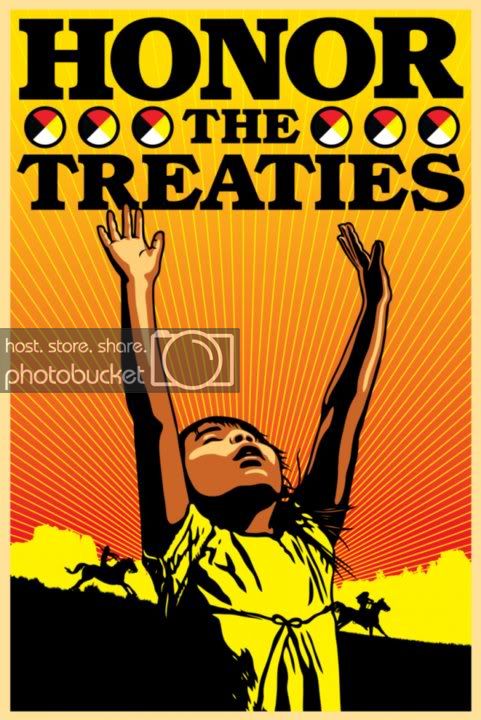
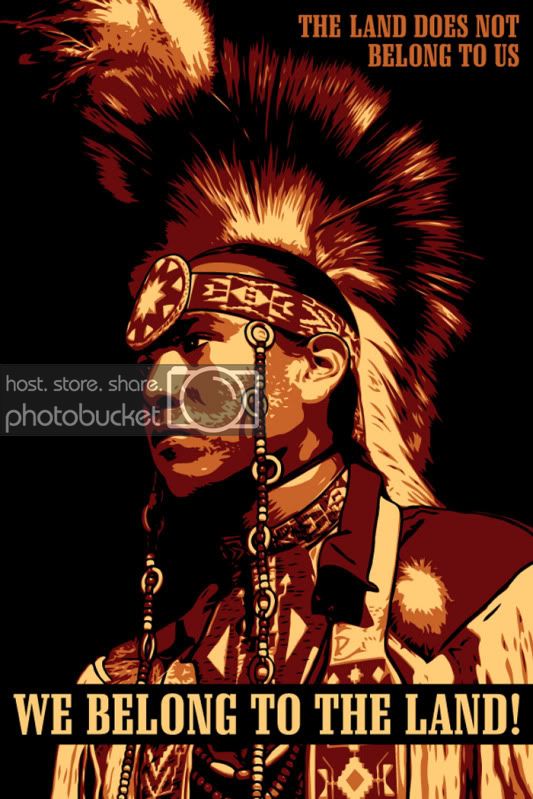
The posters went up in numerous cities. The most impressive installation of this project was a billboard on Melrose Avenue in Los Angeles. Meteor Blades and I watched for five hours as the work was completed by Huey, Fairey and some of their helpers.
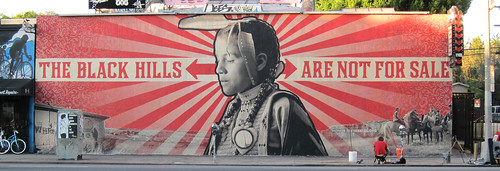
Enough background. In the video below, Huey makes a powerful announcement about his new project:
Video can be seen here: http://www.youtube.com/embed/s… frameborder=”0″
Transcript:
“So I have a confession.
When I tell stories — when we, as journalists tell stories — we miss most of the good stuff. Some of the best stories end up on the cutting room floor because they aren’t “newsworthy,” or flashy, or violent enough. Or because there just isn’t space. The communities we report on know this, and when we leave they are often are left wondering if they will be misrepresented. This is the nature of our business. We have to cut and simplify and flatten incredibly complex worlds so they can fit between car advertisements in ever shrinking print publications.
I know that when I am telling a story about a place or a people my job as a journalist is not to tell EVERY story of every person in a community, but when I go really deep, when I return enough times to see beyond the statistics and obvious stories, when I have to look back into the eyes of the same people after they have seen themselves on our websites or in the pages of our magazines, I want so badly to give them more of a voice.
As a photojournalist who has been working on the Pine Ridge Indian Reservation in South Dakota for the past 7 years I have struggled with this.
I think that I now I have a solution for this dilemma of representation, a solution for both the communities and for the publications.
I have been lucky to find collaborators in this endeavor in Jonathan Harris and his Editorial Director Annie Correal. Jonathan is the creator of influential Internet projects like We Feel Fine, I Want You to Want Me, the Whale Hunt, and most recently the online community called Cowbird.
Together we plan to connect collections of community-generated stories to mainstream media publications through Cowbird.com, a visionary storytelling platform that can be customized and embedded in big media websites.
The key word here is “embedded.” Ultimately, for me, this project is more about redesigning a relationship – between communities and big media – than it is about designing a digital platform. Crowd-sourced and community-generated story sites already exist, but none thus far have been designed to plug directly into multiple Big Media websites. That relationship has not yet been established, and that is where we stand out.
We plan to create networks of local storytellers on Cowbird and connect them to powerful, popular idea-makers starting with National Geographic and moving on to other news and feature publications. These pairings can be started from the inception of a story.
Our first test case is my story about the Oglala Sioux on the Pine Ridge that will run as a cover story in National Geographic this summer. These are a people who have always felt misrepresented by the media.
National Geographic has been visionary in allowing us to co-launch a community story collection on their website. We have already gathered over 50 stories from the Red Cloud High School on Pine Ridge. More schools and story-tellers will follow with a community collection of 100-200 stories ready to accompany my piece when it launches July 15th.
Imagine the power – of involving communities in telling their own stories – and giving them a platform to publish their own unedited voices along side the story done by a journalist.
That new relationship, between those formerly known as the “subject,” and the publication will open up a new kind of transparency and dialogue rarely seen in mainstream journalism.
Launch THEIR stories together with OURS and you have something truly revolutionary.
This is the plug-in interface that will be launched at National Geographic mid-July:
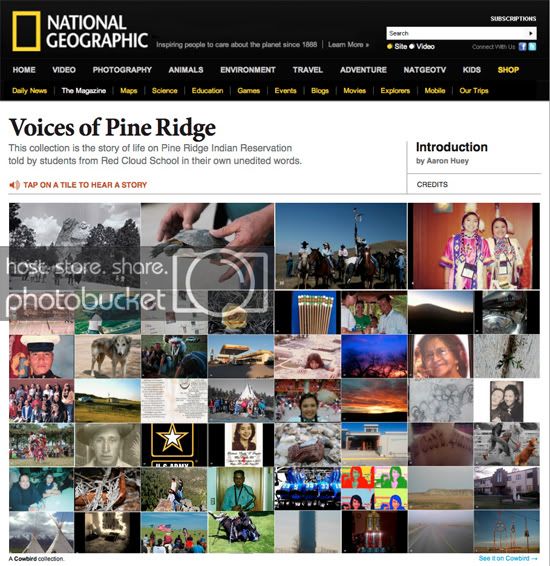
I’m looking forward to exploring all the stories from Pine Ridge this July.

On a related subject, a new short film has been produced about Huey. Once it has premiered in Seattle I’ll provide viewing details for you.
Here’s the trailer:
Honor the Treaties | Trailer from eric becker on Vimeo.A portrait of photographer Aaron Huey’s powerful advocacy work for Native American rights on the Pine Ridge Reservation.
Official Selection, Seattle International Film Festival, 2012
Directed by Eric Becker / weareshouting.com/
Produced by Scott Everett

By Meteor Blades
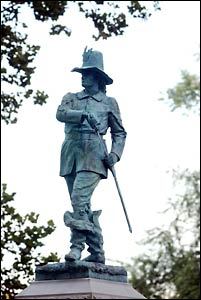
was moved in 1996 to Windsor, Conn.,
from its original location on Pequot Hill,
in Mystic, where he led the 1637 slaughter
of hundreds of women and children.
On May 26, 1637, under the leadership of Capt. John Mason of Connecticut and Capt. John Underhill of Massachusetts Bay Colony, an English militia of 110 soldiers with some 200 Mohegan and Narragansett allies attacked a fortified Pequot village at Missituk, Conn., now Mystic. Inside the fort were 400 to 700 people-historians differ-most of them women, children and old men. Even so, they put up fierce resistance and Mason soon ordered the stockade set afire, its two exits blocked. Inhabitants who managed to climb out were killed. Most of the Pequot warriors were away on a raiding party to Hartford.
It was a turning point in the Pequot War, which had been going on since 1634. The roots of the conflict were deep, a product of growing Puritan immigration into New England and the inevitable friction between them and people whose land was being settled. But the spark that set it off was the slaying of the principal Pequot sachem Tatobem by Dutch traders.
Historians disagree about who responded, the Pequot or the Niantic, who were tributary to the Pequot. Whichever it was attacked Capt. John Stone, an English privateer and smuggler whom the Puritans called “a drunkard, lecher, braggart, bully, and blasphemer.” He and seven of his crew were killed and two Indian captives freed. The Niantic did not realize Stone was English, not Dutch.
The Pequots got the blame. Even though the Puritans had previously ordered Stone out of Plymouth Plantation upon penalty of death after he had threatened the governor with a knife, the death of one of their own by “savages” could not be left to stand. Repeatedly ordered to turn over the killers, the Pequot repeatedly refused. The English retaliated by burning some outlying villages and corn stores. By 1636, the Pequot had begun raiding English settlements with a good deal more seriousness than in years past. In response, a militia was raised and the war was full on. It was fought mostly as skirmishes, nobody getting the upper hand, and both sides seeking to put wedges between traditional allies of the other.
That changed at Mystic. In the days after the massacre, the surviving Pequot were hunted down, killed, sold into Caribbean slavery or forced to join their enemies, the tribe being obliterated until it gained federal recognition three centuries later, in 1983, as the Mashantucket Pequot Tribe of Connecticut.
Historian Alden T. Vaughan wrote in New England Frontier: Puritans and Indians 1620-1675:
“The effect of the Pequot War was profound. Overnight the balance of power had shifted from the populous but unorganized natives to the English colonies. Henceforth [until King Philip’s War in 1675-6] there was no combination of Indian tribes that could seriously threaten the English. The destruction of the Pequots cleared away the only major obstacle to Puritan expansion. And the thoroughness of that destruction made a deep impression on the other tribes.”
The general attitude about the massacre was reflected in the declaration of William Bradford, in his History of the Plymouth Plantation:
“Those that [escaped] the fire were slaine with the sword; some hewed to peeces, others rune throw with their rapiers, so as they were quickly dispatchte, and very few escapted. It was conceived they thus destroyed about 400 at this time. It was a fearful sight to see them thus frying in the fyer, and the streams of blood quenching the same, and horrible was the stincke and sente there of, but the victory seemed a sweete sacrifice, and they gave the prayers thereof to God, who had wrought so wonderfully for them, thus to inclose their enemise in their hands, and give them so speedy a victory over so proud and insulting an enimie.”

American Indian Caucus at Netroots Nation will feature Paulla Dove-Jennings
By Meteor Blades and navajo
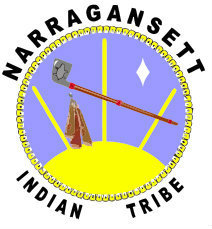
Both of us will be heading out next week to Providence, Rhode Island, for a busy schedule of reconnecting, networking, attending talks, envisioning the future and generally carousing at the Netroots Nation 2012 conference. We hope to meet lots of you there.
We also hope those of you who make it to Providence will attend our reinvented American Indian Caucus. We’re excited to have a special guest this year. Her name is Paulla Dove-Jennings, née Tabautne (aka SunFlower). She’s a member of the Turtle clan of the Narrangansett Tribe of Rhode Island. Her ancestors were the people who lived there for thousands of years before it was Rhode Island. You can read about them in more detail at Invisible Indians at Netroots Nation.
Jennings is an oral historian and story-teller who has spoken all over the nation, including Alaska. She has never spoken in Hawaii or Europe because her grandmother told her never to cross the big waters. At our caucus she will speak about politics and women in the light of the traditional views of her tribe.
Members of the Turtle clan are the keepers of tribal History, family history, and
traditional legends. I am a mother, grandmother, and great-grandmother.
Working as curator of museum Native collections, Tribal Council member, oral
historian, story-teller, and published author have all enhanced my confidence
and knowledge of true story-telling. A story-teller never uses another tribe’s story without permission.
I grew up with my parents, grandparents, and other family elders telling tribal history, family history, and legends in the 1940s, 1950s, and ’60s. I have passed some of my stories on to nieces and nephews as well as my own grandchildren.
Several years ago I invited my mother, Eleanor Spears Dove, to Brown University
to a story-telling event. Seven well-known Rhode Island storytellers of various
ethnic groups presented their stories. All of the presenters used props such as
instruments, music, scarves, sticks, etc. They were wonderful. I told the story of
how the bear lost his tail. My props were the tone of my voice, the shift of my
body, movements of my hands, eye contact, and the lift of my head, leaning
toward the audience and pulling back. I try to build the scene, the weather, the
wind, the sky, the earth, the water, the forest, and the animals.
When the event was over, my mother surprised me by saying she actually saw the bear!
I have told stories from Maine to Alaska, to the young and the old, in cultural
institutions, colleges, universities, schools, powwows, organizations, and private
and social events. I thank the Creator for this gift.

At the caucus, the two of us will also very briefly discuss our rationale and progress with First Nations News & Views and summarize voter suppression against Native people. As many of you know, our proposal for a Netroots Nation panel on the latter subject was rejected for the second time this year. We have not given up trying to make this panel a reality because we strongly believe that our story in this regard is unique and has impacts on the progressive agenda that go well beyond keeping a few thousand American Indians from voting.
There is a panel on voter suppression in general that deserves people’s attention:
Protecting Voting Rights in Communities of Color in 2012
Thursday, June 7, at 4:30 PM to 5:45 PM
Black and brown voters turned out in record numbers in 2008. However, the introduction of voter ID initiatives in many states creates a new barrier for many Americans, particularly in traditionally disenfranchised communities of color. Voters in these communities-as well as students, seniors, the working poor and those with disabilities-will be most impacted. What coalitions and campaigns are underway to ensure these voters have equal access to the polls? How can we ensure that their voting rights are safeguarded and their voices counted? Panelists will provide case studies of campaign strategies and community solutions and tackle tough questions concerning voter ID laws.
In addition to leading our caucus, navajo will be giving a presentation again this year:
Promoting People of Color in the Progressive Blogosphere panel.
Friday, June 8, at 4:30 PM to 5:45 PM
This panel will address the needs, successes and obstacles to having greater participation from people of color in the blogosphere. Using the models of Native American Netroots and Black Kos as a beginning point for the discussion, we’ll cover topics such as color blindness vs. representation and how to get historically underrepresented groups and their views heard. We’ll discuss how to organize outreach between the larger blogosphere and blogs that are specific to communities of color and how to form stronger connections to ongoing organizing efforts and activism in communities of color. We’ll also focus on how organizations can promote diversity within new grassroots organizations.

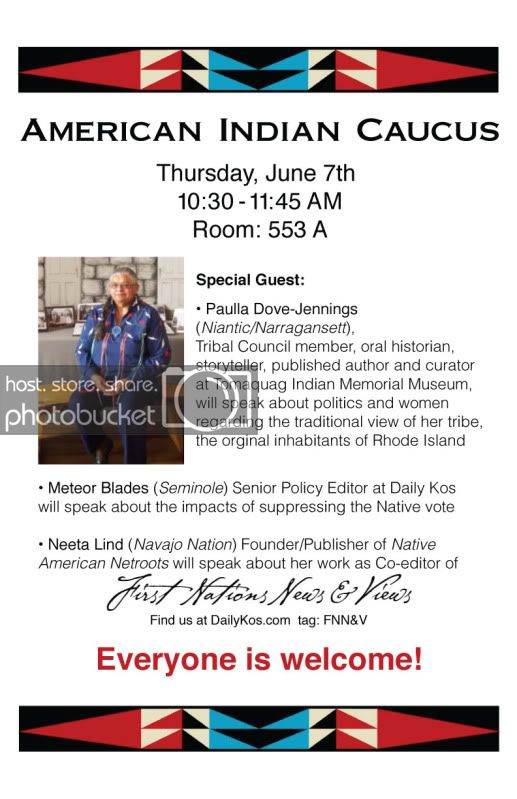

VA Recognizes Benefit of Sweat Lodge Ceremonies for Veterans
By navajo
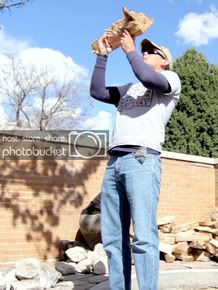
a log in the fire pit. (Photo byTaki Telonidis/NPR)
Ever since the government finally agreed that post traumatic stress syndrome-PTSD-is a real phenomenon, it has been thoroughly covered in the media. We all know now what it is, the havoc it can wreak on individuals, families and society at large, and we continue to develop ways it can be treated.
One new treatment is an old tradition, the sweat house, used to cleanse American Indian warriors of the bad spirits of war and death. Many tribes believe that in war a part of the soldier is left on the battlefield and when veterans return home they need a special ceremony to bring back that part of their spirit, to become complete again. Sweat lodges are common on many reservations. Today they are being used by a special group of American Indian veterans in Utah at the Veterans Administration center in Salt Lake City.
We can’t just walk away from war. The lasting effects of the exposure are real. We go into war knowing that a price has to be paid for going there, for engaging in the taking of lives. If the war is unjust … so much more the cognitive dissonance as well as the reasoning and emotional turmoil as we deal with the conflict in our psyche.
Native veterans are finding relief from anxiety in participating in the sweat ceremony as well as a spiritual connection to their heritage.
A sweat is a ceremony conducted by an Indian spiritual leader, or medicine man, in a dome-shaped structure. A fire is built and about 50 large stones are heated and then placed in the lodge. Water is poured over the hot stones, creating steam. The medicine man sings prayer songs and then, using eagle feathers, he blesses the troubled veterans. Using a scraping motion with the feathers he cleanses them of war.

• Native Swimmer Hopes for Olympic Gold in London:

Synchronized swimmer Mary Killman (Citizen Potowatomie Nation) will be partnered with teammate Maria Koroleva in the duet event at the Olympics this year. She hopes to follow in the footsteps of another Native Olympian, the renowned Jim Thorpe (Sac and Fox), also known as Wa-Tho-Huk (“Bright Path”), who won two gold medals in the 1912 Olympics in Stockholm. He, in fact, is her idol. Killman has been preparing for her moment in the spotlight since she was 11. She now trains ten hours a day, six days a week, both swimming and lifting weights. Like Thorpe, she was born and raised in Oklahoma, a consequence of government policy that relocated 22 tribes there beginning in the 1830s. Thorpe was not the first Indian to participate in the Olympics. In 1904 at St. Louis, the Canadians won the gold medal for lacrosse in a contest against the U.S. team. Among the names of the competitors: Black Eagle, Spotted Tail, Snake Eater and Rain in Face.
Killman says:
“It’s not as easy as it looks […] Synchro is a theatrical sport, like figure skating, where we have the pretty makeup and the big smiles. But under all that-under water-it’s chaos. We’re kicking each other like crazy and trying to hold each other up.”
[For] Koroleva, the most challenging part of the sport-and one of synchro’s biggest misconceptions-is not ever touching the bottom of the pool. “The pools we swim in are at least nine feet deep,” Koroleva says. “There are underwater cameras and referees watching the routine to make sure we never touch the bottom, even by accident.”
-Meteor Blades
• Jim Thorpe Native Games Anticipating 4000 Competitors: Six weeks before Killman has her chance in London, American Indians from across the nation will compete in Oklahoma City, Okla., in the Jim Thorpe Native Games in honor of the 100th anniversary of victories of the great runner. The games, running from today through next Sunday, June 17, comprise 11 competitive sports: baseball, softball, basketball, tennis, stickball, golf, track and field, cross country, wrestling, beach volleyball and martial arts. The week-long event will also include an American Art Exhibition and traditional cultural exhibitions. There will also be an NFL Punt, Pass and Kick competition and a 5-kilometer run. All participants must have a valid Certificate of Degree of Indian Blood.
-Meteor Blades
• Wyoming County Balks Over Fees in Voter Suppression:
Under fire for discrimination against Eastern Shoshone and Northern Arapaho on the Wind River Indian Reservation, Fremont County proposed a partial replacement for the at-large districting system that a federal district court ruled in 2010 violated the Voting Rights Act by diluting the Indian vote. The new system, part of the county’s appeal, would have created an Indian district but kept the rest of the districts at charge. In rejecting the county’s plans, Judge Alan Johnson wrote that county officials “appear to be devised solely for the purpose of segregating citizens into separate voting districts on the basis of race without sufficient justification, contrary to the defendants’ assertions.” The Ten Circuit Court agreed and ruled against the appeal.
Lawyers for the five tribal members who brought the suit have now asked Johnson to award more than $85,000 for their work on the appeal. The plaintiffs’ 2010 request for more than $880,000 for legal work for the original trial is still pending with the same judge. Fremont County, however, says the legal fees are too high and they have filed papers asked the judge to reduce them.
-Meteor Blades
• Children bring joy to prison powwows:

time in years, enter the state penitentiary
in Walla Walla last Tuesday.
(Photo by Matthew Zimmerman Banderas/
Walla Walla Union-Bulletin)
Under a new policy in Washington state, American Indian prison inmates may request that children be allowed to join in annual religious and cultural gatherings behind bars. Including children has already had an impact. “People die inside themselves in here,” said Herbert Rice (Yakama), who remembers teaching his son, now 20, how to grass-dance in a prison visiting room. “These elders here today remind us of who we are, they bring us back to who we are. And the kids, for us, remind us of what we used to be, and they remind us what tomorrow is going to be, especially these young kids here dancing.”
It had been at least five years since some prison superintendents-each one decided individually-last allowed minors to attend Native American powwows inside the state’s 12 correctional facilities. And it’s been two years since the Department of Corrections (DOC) implemented sweeping changes that deemed as contraband the “sacred tobacco” used in Native American ceremonies, authorized hands-on property searches of ceremonial items that were reclassified as “nonsacred,” and curtailed sweat-lodge ceremonies due to the cost of firewood. As part of the change, barring children from religious or cultural events was codified in DOC policy. […]
“DOC, with basically a sweep of a pen, erased all these religious, tribal, spiritual and ceremonial rights,” said Gabe Galanda, a Seattle attorney who worked on behalf of Native inmates. […]
“It’s taken us two years, through a lot of diplomatic effort and patience, to get everything back,” Galanda said. The one thing still missing, however, was the inclusion of children – often referred to as “shorties” – at powwows. […]
A few weeks ago, the DOC – after months of discussions about security and the need to protect children, especially from incarcerated sex offenders – decided to allow children to attend the first powwow of the summer season at the prison in Walla Walla. As a result of tribal leaders’ efforts, other religious groups – be they Catholics or Muslims – now can also request that children be allowed to participate in their annual religious or cultural events, Galanda said.
-Meteor Blades
• Oglala Ready to Take Control of First Tribal National Park:
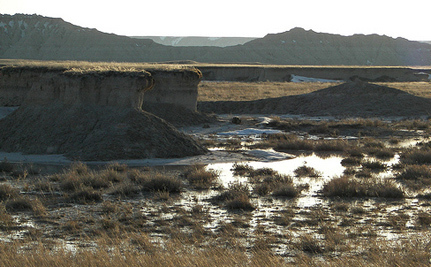
It appears a wrong may soon be partially righted. The South Unit of the Badlands National Park, 133,000 acres entirely within the boundaries of the Pine Ridge Reservation of South Dakota, may become the first ever tribally run National Park. The history of how that land came not to be in control of the tribe in the first place has a familiar ring. In the cautious language of the National Parks Traveler:
The South Unit of Badlands National Park is an oddity, having been born of an administrative decision that incorporated a large tract of Indian-owned land into a national park in a rather heavy-handed manner. A gunnery and bombing range was established on [Lakota] land in 1942 shortly after America entered World War II. When the range was declared excess and closed in the 1960s, it was returned to the Oglala Sioux in the form of a government-held trust, and with the provision that it be part of the expanded Badlands National Monument. A Memorandum of Agreement stipulated that the OST-owned land was to be managed by the National Park Service.
Translation: The government took the land and the Oglala were told to shove it. Once the government gave up using the land for target practice, the Oglala and the Park Service reached a new agreement to govern the park and, in 1978, Congress redesignated the monument as Badlands National Park. Scroll forward another 25 years to 2003 and the Oglala requested government-to-government negotiations over future management of the South Unit. The Park Service is ready to go wholly to tribal management, but that will take an act of Congress..
“Our National Park System is one of America’s greatest story tellers,” Interior Secretary Ken Salazar said: “As we seek to tell a more inclusive story of America, a tribal national park would help celebrate and honor the history and culture of the Oglala Sioux people. Working closely with the Tribe, Congress, and the public, the Park Service will work to develop a legislative proposal to make the South Unit a tribal national park.” A map of the park can be found here.
-Meteor Blades
• Poll: N.D. Voters Will Reject ‘Fighting Sioux’ Nickname:
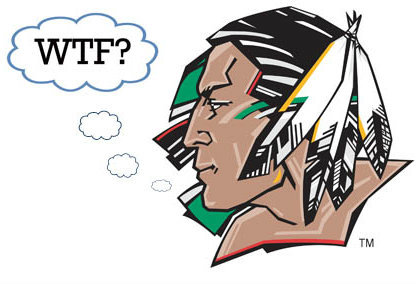
What could be the end of the tortuous path taken by supporters and foes of the “Fighting Sioux” nickname and logo of the University of North Dakota will June 12. That’s when voters will give thumbs up or thumbs down on whether UND should retire the “Fighting Sioux” or keep the name in the face of NCAA sanctions. The battle has been going on since 2006 when the NCAA told all participating college teams that it will allow no more Indian-themed mascots, nicknames and logos except in those cases, like the Florida Seminoles, when the tribes agreed to their use. As we have reported here and here and the nickname dispute in North Dakota has involved the state’s two Dakota (Sioux) tribes (who disagree with each other), the governing board of UND, the state legislature and the state supreme court. The poll shows 56 percent favor Measure 4, which would allow UND to ditch the name, and 44 percent want to require the university to keep it.
-Meteor Blades
• USDA Chief Names 11 to Native Council: As part of the 2010 settlement in the Keepseagle v. Vilsack lawsuit, Agriculture Secretary Tom Vilsack has appointed 11 American Indians to two-year terms on the Council on Native American Farming and Ranching. The lawsuit alleged discrimination against Indians by the USDA in its farm loan program. The council, which is only advisory in nature, will suggest changes to Farm Service Agency regulations, make suggestions for ways to boost participation of Native farmers and ranchers in all other USDA programs and support government-to-government relations between USDA and tribal governments. In the modern era, the government-to-government approach dates back to the Indian Reorganization Act of 1934, to President Richard Nixon’s 1971 formal ending of the tribal termination acts of ’50s and ’60s and to an executive order on such matters by President Bill Clinton in 1994. Making the government-to-government approach with the tribes across all U.S. executive departments actually happen obviously loses something from the signed paper to actual implementation. The council, The 11 councilmembers are Gilbert Harrison (Navajo Nation), rancher; Henry Holder (Choctaw Nation), farmer/rancher; Michael Jandreau (Lower Brule Sioux Tribe), tribal chairman; Gerald Lunak, natural resources director (Blackfeet Nation); Jerry McPeak, (Muscogee Nation), farmer/rancher and Oklahoma state legislator; Lance Morgan (Winnebago Tribe of Nebraska), CEO of Ho-Chunk, Inc.; Angela Sandstol, (Native Tribe of Tyonek), natural resources and conservation official; Edward Soza (Soboba Band of Luiseno Indians), farmer/rancher; Mary Thompson (Eastern Band of Cherokee Indians), farmer/rancher; Sarah Vogel (civil rights attorney and former agricultural commissioner for North Dakota); Mark Wadsworth, (Shoshone-Bannock Tribes).
-Meteor Blades
Indians have often been referred to as the “Vanishing Americans.” But we are still here, entangled each in his or her unique way with modern America, blended into the dominant culture or not, full-blood or not, on the reservation or not, and living lives much like the lives of other Americans, but with differences related to our history on this continent, our diverse cultures and religions, and our special legal status. To most other Americans, we are invisible, or only perceived in the most stereotyped fashion.First Nations News & Views is designed to provide a window into our world, each Sunday reporting on a small number of stories, both the good and the not-so-good, and providing a reminder of where we came from, what we are doing now and what matters to us. We wish to make it clear that neither navajo nor I make any claim whatsoever to speak for anyone other than ourselves, as individuals, not for the Navajo people or the Seminole people, the tribes in which we are enrolled as members, nor, of course, the people of any other tribes.
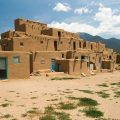
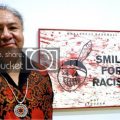
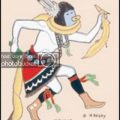

Leave a Reply